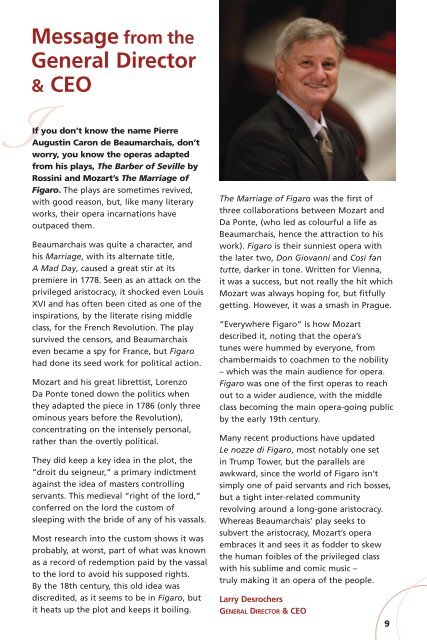Raquelle
URpxR
URpxR
Create successful ePaper yourself
Turn your PDF publications into a flip-book with our unique Google optimized e-Paper software.
Message from the<br />
General Director<br />
& CEO<br />
If you don’t know the name Pierre<br />
Augustin Caron de Beaumarchais, don’t<br />
worry, you know the operas adapted<br />
from his plays, The Barber of Seville by<br />
Rossini and Mozart’s The Marriage of<br />
Figaro. The plays are sometimes revived,<br />
with good reason, but, like many literary<br />
works, their opera incarnations have<br />
outpaced them.<br />
Beaumarchais was quite a character, and<br />
his Marriage, with its alternate title,<br />
A Mad Day, caused a great stir at its<br />
premiere in 1778. Seen as an attack on the<br />
privileged aristocracy, it shocked even Louis<br />
XVI and has often been cited as one of the<br />
inspirations, by the literate rising middle<br />
class, for the French Revolution. The play<br />
survived the censors, and Beaumarchais<br />
even became a spy for France, but Figaro<br />
had done its seed work for political action.<br />
Mozart and his great librettist, Lorenzo<br />
Da Ponte toned down the politics when<br />
they adapted the piece in 1786 (only three<br />
ominous years before the Revolution),<br />
concentrating on the intensely personal,<br />
rather than the overtly political.<br />
They did keep a key idea in the plot, the<br />
“droit du seigneur,” a primary indictment<br />
against the idea of masters controlling<br />
servants. This medieval “right of the lord,”<br />
conferred on the lord the custom of<br />
sleeping with the bride of any of his vassals.<br />
Most research into the custom shows it was<br />
probably, at worst, part of what was known<br />
as a record of redemption paid by the vassal<br />
to the lord to avoid his supposed rights.<br />
By the 18th century, this old idea was<br />
discredited, as it seems to be in Figaro, but<br />
it heats up the plot and keeps it boiling.<br />
The Marriage of Figaro was the first of<br />
three collaborations between Mozart and<br />
Da Ponte, (who led as colourful a life as<br />
Beaumarchais, hence the attraction to his<br />
work). Figaro is their sunniest opera with<br />
the later two, Don Giovanni and Così fan<br />
tutte, darker in tone. Written for Vienna,<br />
it was a success, but not really the hit which<br />
Mozart was always hoping for, but fitfully<br />
getting. However, it was a smash in Prague.<br />
“Everywhere Figaro” is how Mozart<br />
described it, noting that the opera’s<br />
tunes were hummed by everyone, from<br />
chambermaids to coachmen to the nobility<br />
– which was the main audience for opera.<br />
Figaro was one of the first operas to reach<br />
out to a wider audience, with the middle<br />
class becoming the main opera-going public<br />
by the early 19th century.<br />
Many recent productions have updated<br />
Le nozze di Figaro, most notably one set<br />
in Trump Tower, but the parallels are<br />
awkward, since the world of Figaro isn’t<br />
simply one of paid servants and rich bosses,<br />
but a tight inter-related community<br />
revolving around a long-gone aristocracy.<br />
Whereas Beaumarchais’ play seeks to<br />
subvert the aristocracy, Mozart’s opera<br />
embraces it and sees it as fodder to skew<br />
the human foibles of the privileged class<br />
with his sublime and comic music –<br />
truly making it an opera of the people.<br />
Larry Desrochers<br />
General Director & CEO<br />
9


